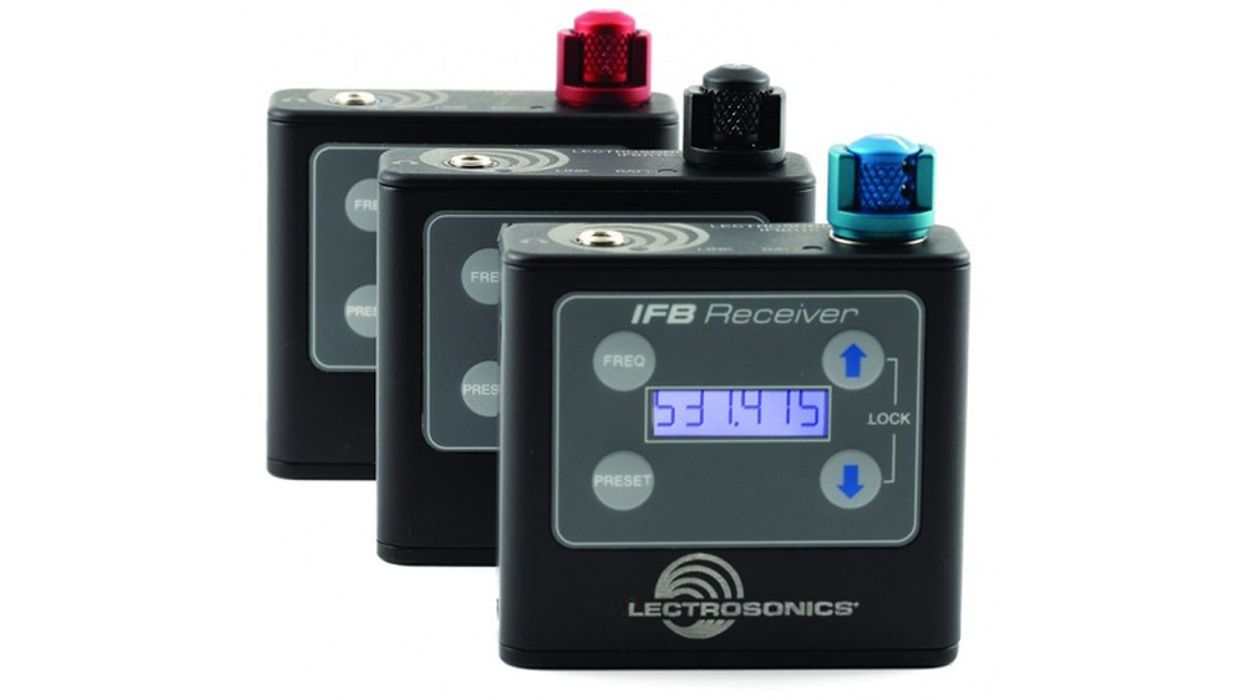Lectrosonics Miniaturizes Its IFB Lineup with New IFBR1B Receiver
A tiny IFB that packs punch.

Lectrosonics has introduced a new interruptible foldback (IFB) receiver dubbed IFBR1B, which has been redesigned to be half the size and weight of its previous model, the IFBR1a.
IFB systems are an easy way for filmmakers to listen to the program audio of a production while on set. You may hear them referred to as "Comteks," a name that has become synonymous with the functionality. The main differences between Comtek and Lectrosonics is operating distance, power output, tuning range, and cost. Sound quality is debatable. However, the Lectrosonics models tend to offer better RF performance, but usually costs twice as much as Comtek.
Let's see how the IFBR1B receiver stacks up.
Key Features
- 10 frequency presets
- LCD interface
- 8 hour battery life
- Dock chargeable

There are five models of the IFB1B that provide different tuning ranges. Each is distinguished by a red, blue, or black top knob, which acts as the power button and volume control.
- Red: (VHF) 174-216 MHz
- Blue: (UHF) A1 470-537 MHz
- Blue: (UHF) B1 537-614 MHz
- Blue: (UHF) C1 614-692 MHz
- Black: (North American 941 band) 941-960 MHz
If you're wondering why the blue model doesn't include the full tuning range of 470-692 MHz, Lectrosonics says there's a trade off in either performance and cost. The sweet spot for analog receivers being around 75 MHz wide. The frequency steps for UHF can be adjusted in 25 or 100 kHz and 125 kHz for VHF.
The top of the unit has a mono/stereo 3.5mm input, which can power earbuds, headphones, or induction neck loops. There's also a battery indicator light and a RF signal LED that will light up blue when a signal from a transmitter is received. While on the subject of transmitters, the IFBR1B is completely compatible with existing Lectrosonics IFBT4 transmitters.
For future firmware updates or to mitigate any impact on the shrinking wireless spectrum, Lectrosonics has included an USB input on the bottom of the unit. It's also where to find the battery compartment, which has a sliding door for easy access.
Besides the smaller footprint, another difference between the two models is power. The IFBR1B uses a rechargeable 3.6V LB-50 lithium-ion battery, while the IFBR1a took advantage of an everyday 9V . The LB-50 touts 1000mAh and should provide around 8 hours of run time on the IFBR1B. Each battery costs around $45, but it's worth noting it's compatible with the Lectrosonics SSM transmitter. This is a smart move by the company–the more products that can be used with the same battery type the better.
Other features include much of what made the IFBR1a work so well, including a 20 kHz deviation and a Pilot Tone squelch that silences audio when there's no signal.
Along with the IFBR1B, Lectrosonics has introduced a dock charging system, the CHSIFBR1B to charge the LB-50 batteries. It's capable of charging up to four receivers or four batteries in any combination. The batteries of the IFB1RB do not need to be removed in order to be charged. The unit can be ganged in groups of four and charge up to 16 batteries on a single power supply. Oddly, Lectrosonics does not include the DCR5/9AU power supply with the charging station. It must be purchased separately. It takes about three hours to charge a battery with the docking station.
Price & Availability
The IFBR1B comes with a belt clip, battery, and velcro strain relief for $725. The CHSIFBR1B charging system is $599 and the DCR5/9AU power supply is $79. Expected release date is April 2020. There's also a single charging station (40107) for around $50 and a rack-mountable charging station, the CHS12LB50, that can charge up to 12 LB-50 batteries.













